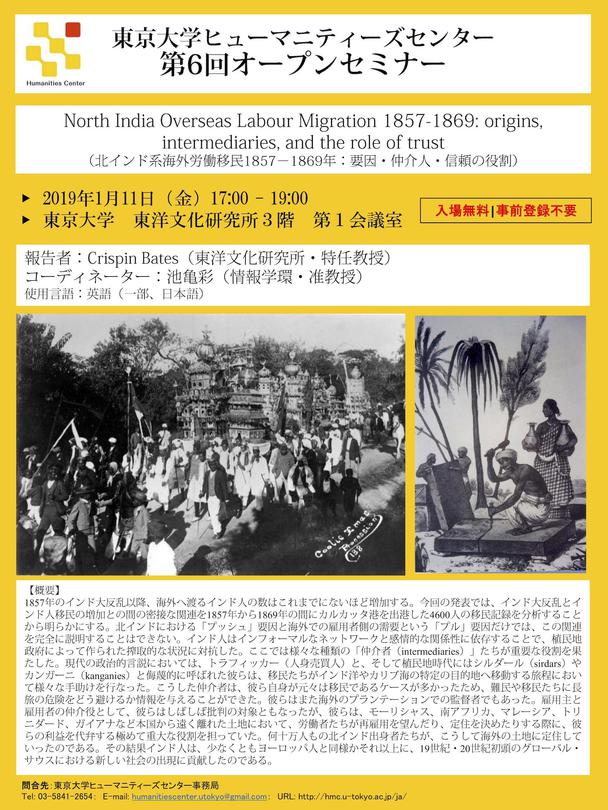North India Overseas Labour Migration 1857-1869: origins, intermediaries, and the role of trust(北インド系海外労働移民1857−1869年:要因・仲介人・信頼の役割)

- 日時:2019年1月11日(金)17:00 - 19:00
- 場所:東京大学 東洋文化研究所3階 第1会議室(入場無料 事前登録不要)
- 報告者:Crispin Bates(東洋文化研究所・特任教授)
- コーディネーター:池亀彩(情報学環・准教授)
- 使用言語:英語(一部、日本語)
Indians travelled in unprecedented numbers overseas following the great Indian Uprising of 1857. This paper argues that there was an intimate connection between these two events: demonstrated by an analysis of 4,600 migrants from the port of Calcutta between 1857 and 1869. However, 'push' factors from north India and 'pull' factors arising from the demands of employers were only part of this story. Indians used informal networks and affective relationships to counter the exploitative arrangements set in place by colonial governments. Crucial to their migrations were intermediaries of various sorts. Known as 'traffickers' in contemporary political discourse, or as 'sirdars' and 'kanganies' in colonial times, they assisted migrants in their journeys to specific destinations around the Indian Ocean and in the Caribbean. These intermediaries were usually themselves 'old migrants' who could inform refugees and migrants how best to avoid the hazards of their long journey. They also acted as overseers on overseas plantations. As middle-men between the employers and workers, they were commonly criticised. However they performed a vital service, especially when it came to representing the worker's interests if they chose to re-indenture and settle in far-flung destinations such as Mauritius, South Africa, Malaysia, Trinidad and Guyana. Hundreds of thousands of Bhojpuris and their families chose to do just that. As result, Indians contributed at least as much as Europeans to the building of new societies across the global south in the 19th and early 20th centuries.
1857年のインド大反乱以降、海外へ渡るインド人の数はこれまでにないほど増加する。今回の発表では、インド大反乱とインド人移民の増加との間の密接な関連を1857 年から1869年の間にカルカッタ港を出港した4600人の移民記録を分析することから明らかにする。北インドにおける「プッシュ」要因と海外での雇用者側の需要という「プル」要因だけでは、この関連を完全に説明することはできない。インド人はインフォーマルなネットワークと感情的な関係性に依存することで、植民地政府によって作られた搾取的な状況に対抗した。ここでは様々な種類の「仲介者(intermediaries)」たちが重要な役割を果たした。現代の政治的言説においては、トラフィッカー(人身売買人)と、そして植民地時代にはシルダール(sirdars)やカンガーニ(kanganies)と侮蔑的に呼ばれた彼らは、移民たちがインド洋やカリブ海の特定の目的地へ移動する旅程において様々な手助けを行なった。こうした仲介者は、彼ら自身が元々は移民であるケースが多かったため、難民や移民たちに長旅の危険をどう避けるか情報を与えることができた。彼らはまた海外のプランテーションでの監督者でもあった。雇用主と雇用者の仲介役として、彼らはしばしば批判の対象ともなったが、彼らは、モーリシャス、南アフリカ、マレーシア、トリニダード、ガイアナなど本国から遠く離れた土地において、労働者たちが再雇用を望んだり、定住を決めたりする際に、彼らの利益を代弁する極めて重大な役割を担っていた。何十万人もの北インド出身者たちが、こうして海外の土地に定住していったのである。その結果インド人は、少なくともヨーロッパ人と同様かそれ以上に、19世紀・20世紀初頭のグローバル・サウスにおける新しい社会の出現に貢献したのである。


